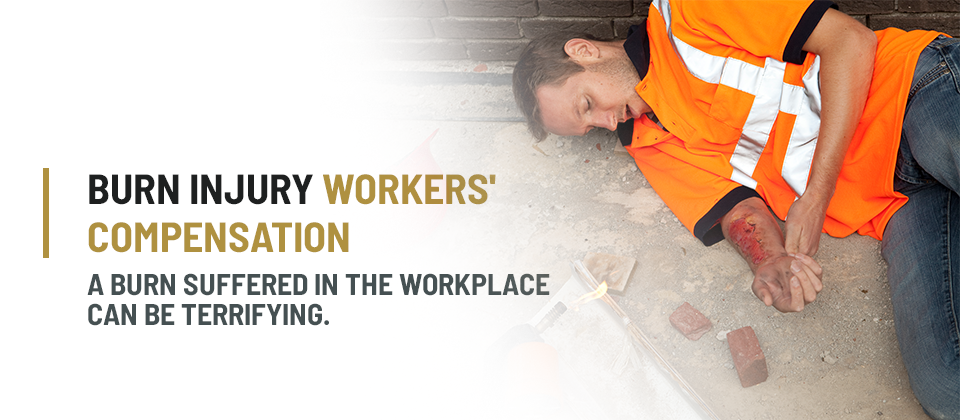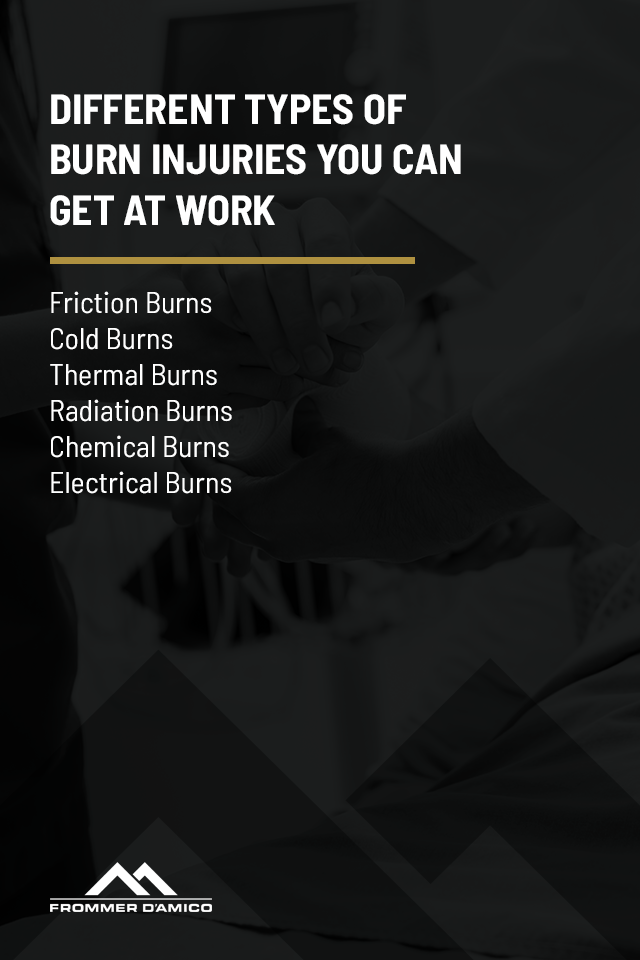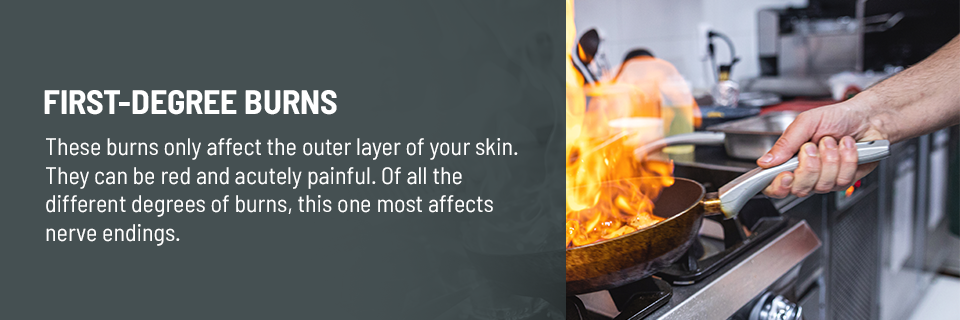Table of Contents
Free Case Review I Want to File a Claim
A burn suffered in the workplace can be terrifying. One moment, you are working as usual. The next moment, the unthinkable can happen. An explosion occurs, a carefully tended fire breaks free or an electrical spark ignites. Fires are severe, scary accidents that can inflict long-term damage to anyone nearby. You might get a burn on your face, hands, legs or elsewhere on your body that prohibits you from working.
If this happens to you, you do not have to go through this isolating experience alone. We can assist you in securing the workers’ compensation benefits you deserve from your accident. Workers’ comp pays part of your wages and medical bills. The law requires Pennsylvania employers to provide workers’ compensation to all part- and full-time employees, as well as seasonal ones.
Burn Treatment Compensation You Can Expect
An injured worker who has suffered a burn-related work injury often faces extensive medical bills and treatment, and months or years of recovery. It’s not unthinkable that this medical treatment may reach five or six figures. Severe burn victims may never be able to return to work.
Under the workers’ compensation system in Pennsylvania, any worker who suffers a burn-related injury, whether temporary or permanent, is eligible for compensation. Injured workers may be eligible for smaller amounts for 2nd degree burns workers’ compensation versus 3rd degree burn settlement amounts. This compensation for burns includes wage-loss benefits of two-thirds of their average weekly wage, up to a limit of $1,049 a week. Workers’ compensation will also pay for all medical bills. Workers’ compensation does not pay benefits for pain and suffering.
Burn injuries may also result in other forms of compensation. People may be eligible for 2nd degree burns workers’ compensation and 3rd degree settlement amounts. Often, the best way to determine the amount of the settlement is the Schedule of Losses. Under the Schedule of Losses, an injured worker who loses the use of part of their body or becomes disfigured may be eligible for a certain number of weeks of compensation. For instance, if a severe burn causes a worker to lose the use of their arm, they may qualify for as much as 410 weeks of compensation.
A physician examines the injured worker and determines the percentage of loss they have suffered. So if an injured worker has suffered the loss of 50% of the use of their arm, they would be eligible for 205 weeks of compensation.
How Do I Pursue PA Workers’ Compensation After a Burn Injury?
Burns are debilitating. You may want to return to work, but your injury likely will keep you away for weeks, months or even years. Often, burns require complicated medical attention, such as:
- Skin grafts
- Treatment of nerve damage
- Cosmetic surgery
- Physical therapy
You may also receive a prescription for pain medication and feel pain for a long time after the injury. You may not be in the right frame of mind to fight for your workers comp for burns benefits, but you need to secure them in order to care for yourself and your family while you are out of work. An experienced lawyer can assist you with this process.
Filing burn injury compensation claim requires attention to detail. You need to make sure you have filled everything out correctly, or you could be turned away on a technicality. Your employer’s insurance company does not want to pay benefits, and they will take advantage of any loophole to avoid having to give you money. You should consider hiring a workers’ compensation attorney to help.
Do You Need a Workers’ Compensation Attorney?
The workers’ compensation for burns at work process can be complicated and anattorney will be able to help you navigate the system. Here are some situations you may find yourself in:
The injured worker will continue to receive medical costs until a doctor determines no further medical improvement is likely or there is a full recovery. There can often be a difference of opinion among doctors about the severity of a burn and how long treatment may be necessary. If you find yourself in this situation, you should immediately seek the help of an experienced burn injury compensation attorney in Pennsylvania.
It is also possible for a worker who suffered a severe burn injury to claim burn injury compensation via a lawsuit against others who may have contributed to the injury. For instance, if your burn was the result of a defective product, you can launch a personal injury lawsuit against the maker. If athird party, other than your employer, is responsible for your burn, you may be able to launch a lawsuit against them.
Your burn at work compensation benefits do not end if you launch a personal injury lawsuit against a third party. Your employer or their insurance company, however, may ask you to repay some of your workers’ compensation costs if you receive damages.
Different Types of Burn Injuries You Can Get at Work
Workers suffer burn injuries more frequently than many people may think. In 2017, 3,320 workers suffered work-related burns in jobs that ranged from agriculture to retail, mining, transportation and hospitality.
Fire continues to be the most common reason for more severe burns, but workers can suffer burns in several ways.
1. Friction Burns
Anyone who ever had to climb a rope in junior high and then slid back down knows what a friction burn is. Or, if you’ve ever fallen on a cement court while playing tennis or basketball and skinned your knee, your elbow or your hands, these are also friction burns. A hard object removes some of your skin from your hand, your elbow, your knee, etc. It’s both a burn and a scrape or abrasion.
A severe friction burn can rub off extensive areas of skin, exposing nerve endings and resulting in in sharp pain. There may be heavy bleeding at first. Healing occurs rapidly, unless infection results.
Friction burns can occur in almost any kind of job or profession, but they are common in motorcycle or bicycle accidents. For that reason, motorcycle police officers and bike messengers are more likely to be friction burn injury victims.
2. Cold Burns
Cold burns, more commonly known as “frostbite,” occur when your skin freezes. You are at risk of frostbite when you are outside for long periods, when you work in a refrigerated facility or if your skin touches a freezing item for a prolonged period.
Frostbite happens most often to toes, feet, ears, nose, fingers, cheeks or chin. You may not even be aware that you have gotten frostbitten because of the numbness that often occurs.
Professions frequently at risk of frostbite include anyone who works outside in below-freezing weather, like road repair crews, agricultural workers, workers who repair telephone or electrical lines, shopping cart attendants at busy malls during the winter, athletes and first responders.
3. Thermal Burns
When you touch a scalding object, like hot metal, the temperature of your skin raises to the point that the skin cells on the part of your body that touch the hot object begin to die. You don’t need to contact something, however, to suffer a thermal burn — scalding liquids or steam can cause one as well.
Professions at risk of suffering thermal burns include anyone who works in the mining industry, transportation and hospitality workers, particularly those who work in food preparation. Anyone who works around hot liquids, such as a cook or server in a restaurant, is also in danger of spilling something on themselves and suffering a thermal burn.
4. Radiation Burns
Most people have had a radiation burn in the form of a sunburn. Most sunburns are relatively mild, and you can treat them with lotions that contain aloe vera or honey. It is possible to get a second-degree sunburn if you remain outside in the sun for too long.
Bad sunburns can be debilitating, and possibly lead to other issues like sunstroke or severe dehydration.
Radiation burns can also occur to people who work in X-ray facilities at hospitals or UV radiation therapy to help cure cancer.
Professions most at risk from radiation burns include any worker outside for long hours in the summer, such as road repair crews, agricultural workers, bike messengers, construction, lifeguards, hospitality workers, grounds and lawn care maintenance workers, as well as hospital technicians who work with X-ray or radiation machinery.
5. Chemical Burns
Chemical burns result from contact with solvents, acids or detergents. Chemical burns can be quite severe, often leading to second or even third-degree burns. If you suffer any chemical burn, even what appears to be a mild one, seek immediate medical attention. Chemical burns can affect your internal organs.
Professions that regularly deal with chemical burns include hazardous waste removal, manufacturing, janitorial, painting, dental hygienists, auto mechanics, mining and transportation.
6. Electrical Burns
Any time someone contacts an electrical current, it usually results in an electrical burn. It’s essential to seek medical help in this situation, since electrical burns can often result in damage to internal organs. An electrical burn may result in temporary or permanent damage, depending upon how long the individual is in contact with the current.
Professions the most at risk include construction, electrician, appliance repair, plant worker, utility worker, agriculture and anyone working outside in a thunderstorm.
Understanding Types of Burns
Seek immediate medical attention if you suffer a burn-related injury on the job, even if it appears to be a minor one. The EMT, doctor or nurse treating you classifies your burn to understand the best way to treat it.
Burns normally fall into four categories, from first-degree to fourth-degree. The higher the degree of the burn, the worse it is.
1. First-Degree Burns
First-degree burns are relatively minor. A first-degree burn occurs when you pick up a plate that’s too hot, get a mild sunburn, momentarily touch a too-hot car engine or brush up against a pan on the stove.
These burns only affect the outer layer of your skin. They can be red and acutely painful. Of all the different degrees of burns, this one most affects nerve endings. So even though it is the least damaging kind of burn, initially, it may be the most painful.
2. Second-Degree Burns
Second-degree burns injure your epidermis, which is your skin’s outer layer, and some of the dermis underneath it. They are known as partial-thickness burns. Second-degree burns are often painful and normally require more than care than is available from a first-aid kit.
Second-degree burns, especially those that cover a large area of the body, can take several weeks to heal, may leave scars or discoloration of the skin and may become infected if not treated promptly and properly.
3. Third-Degree Burns
Third-degree burns are severe burns that affect each layer of skin, which is why they are also known as a full-thickness burn. Third-degree burns almost always need surgery to repair them properly and prevent scarring. When someone suffers a third-degree burn, the skin can have a white, waxy color, with a raised, leathery texture. The skin may also have a charred appearance.
One common misconception about third-degree burns is that they are very painful. The truth is that these burns go so deeply into the skin they destroy the nerves. People who suffer third-degree burns may experience shock and numbness, but not pain.
4. Fourth-Degree Burns
These are incredibly severe burns that often result in death. Fourth-degree burns impact every layer of skin, muscle and bone. They result in extensive nerve damage, major scarring, disfigurement and blistering.
Fourth-degree burns often occur as a result of fires in buildings or in vehicles, chemical spills, prolonged contact with a hot stove or a hot iron or falling into an open flame, such as you would have at a campsite or in a fireplace. As with a third-degree burn, an individual who suffers a fourth-degree burn may not feel any pain because of the extensive damage to their nerves.
Treating Burn Injuries
The correct treatment for burn injuries depends upon the severity of the burn injury. Of course, your doctor is the best source for the type of treatment needed for your specific injury. Generally speaking, here are some examples of treatment for burns:
1. First-Degree Burns
First-degree injuries typically only require home care or treatment from a first-aid kit.
- Soak the burn for five minutes in cool water.
- Take Tylenol or ibuprofen for pain relief.
- Apply aloe vera, honey or a gel with lidocaine on the burn.
- Apply antibiotic ointment and loose gauze.
2. Second-Degree Burns
For a mild second-degree burn:
- Run cool water over the burn for 15 minutes or longer.
- Take over-the-counter pain medication, such as Tylenol or ibuprofen.
- Put antibiotic cream on blisters.
If the second-degree burn is more severe, seek medical treatment immediately, especially if the burn affects a large area of skin, such as the face, the groin, the feet or the hands.
3. Third-Degree Burns
Do not ever try to treat a third-degree burn on your own. Seek emergency medical treatment immediately. While waiting for treatment, if possible, raise the injured area above your heart. Do not take off your clothes, but make sure none of your clothing is sticking to the burn.
For third- and fourth-degree burns, it is very likely you will need skin grafts.
4. Fourth-Degree Burns
Fourth-degree burns always require immediate medical attention. While waiting for medical attention:
- Try to raise the injured area of the body above the heart.
- Use a piece of cloth or loose bandage to cover the affected area.
- People who suffer fourth-degree burns often lose heat through the injured area. If they appear cold, cover them with a light sheet or blanket.
- If the burn is chemical, flush the burned area with water.
Get in Touch With Our PA Burn Injury Lawyers Today
Navigating the workers’ compensation process can feel frustrating, especially when you’re dealing with a severe injury and trying to devote time to recovery and rehabilitation. Having an experienced workers’ compensation attorney advocating for you can make you feel less isolated and take all the necessary steps to secure the best outcome in your case.
Frommer D’Amico has assisted many people in getting compensation for burn injuries suffered at work. We only take workers’ comp cases, we only represent employees and we charge lower fees than other firms. Set up a free consultation with us today by calling 717-400-1000 or contacting us online, and we will meet you at your location.




